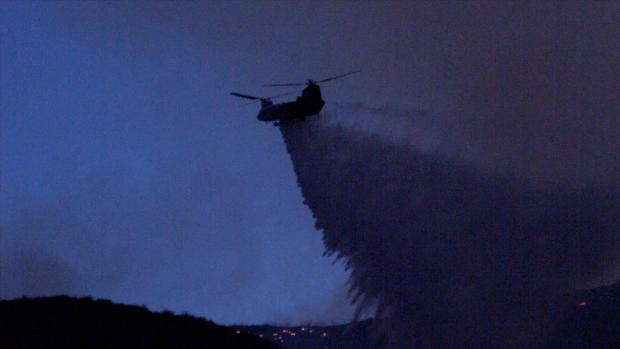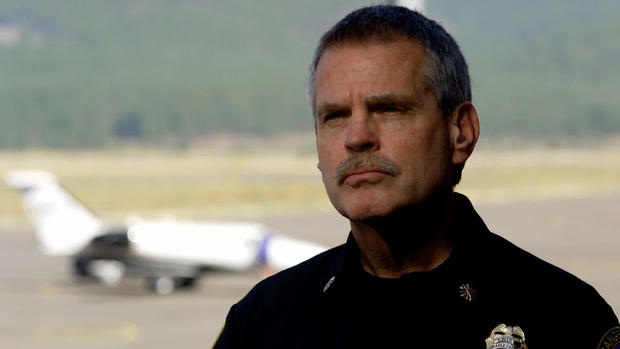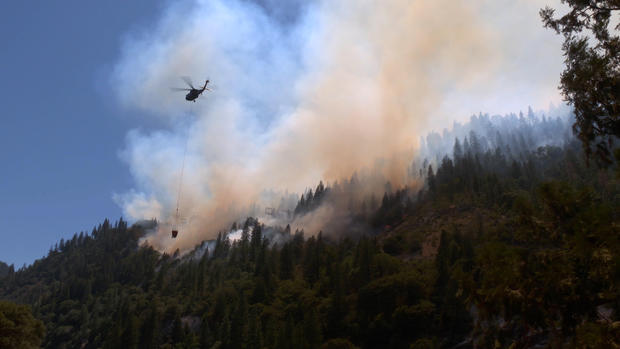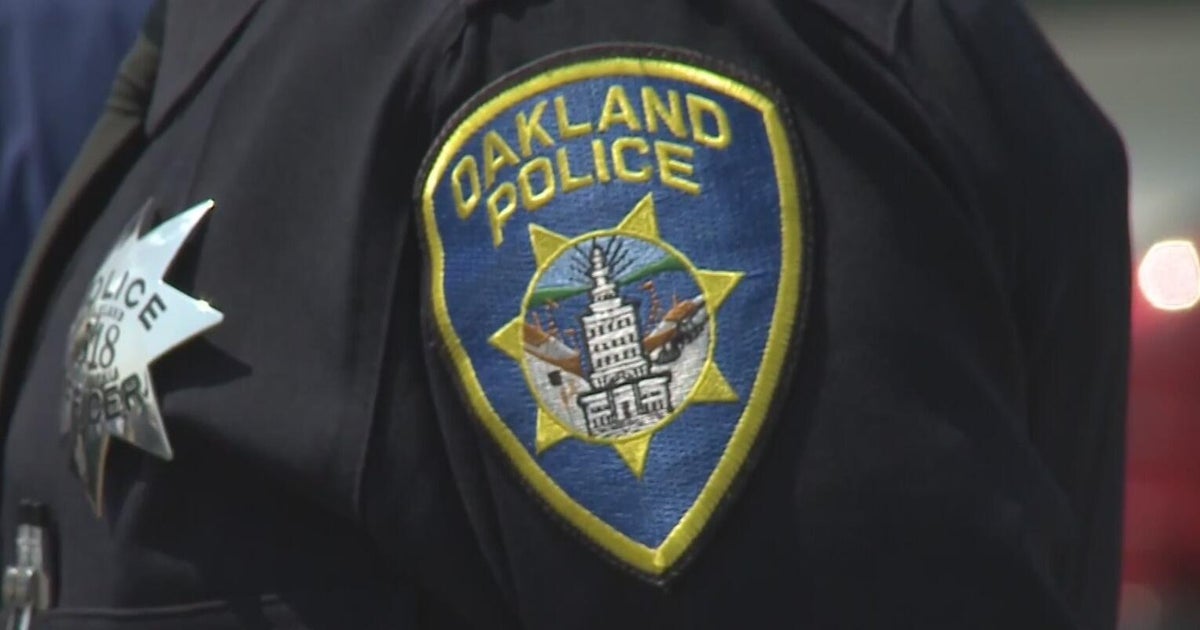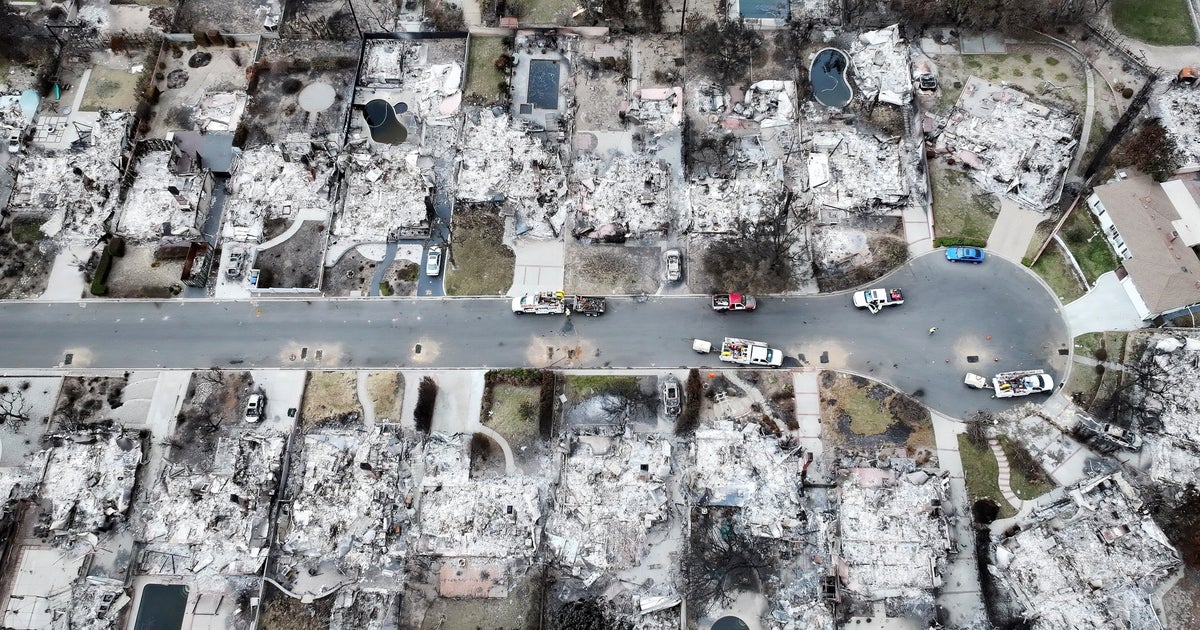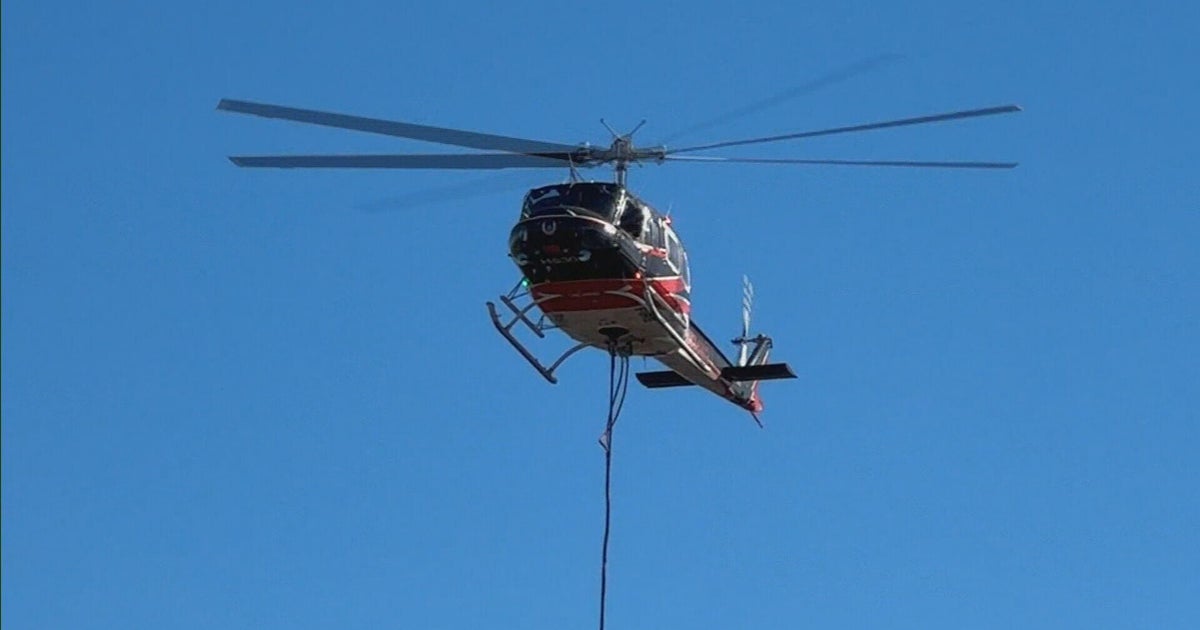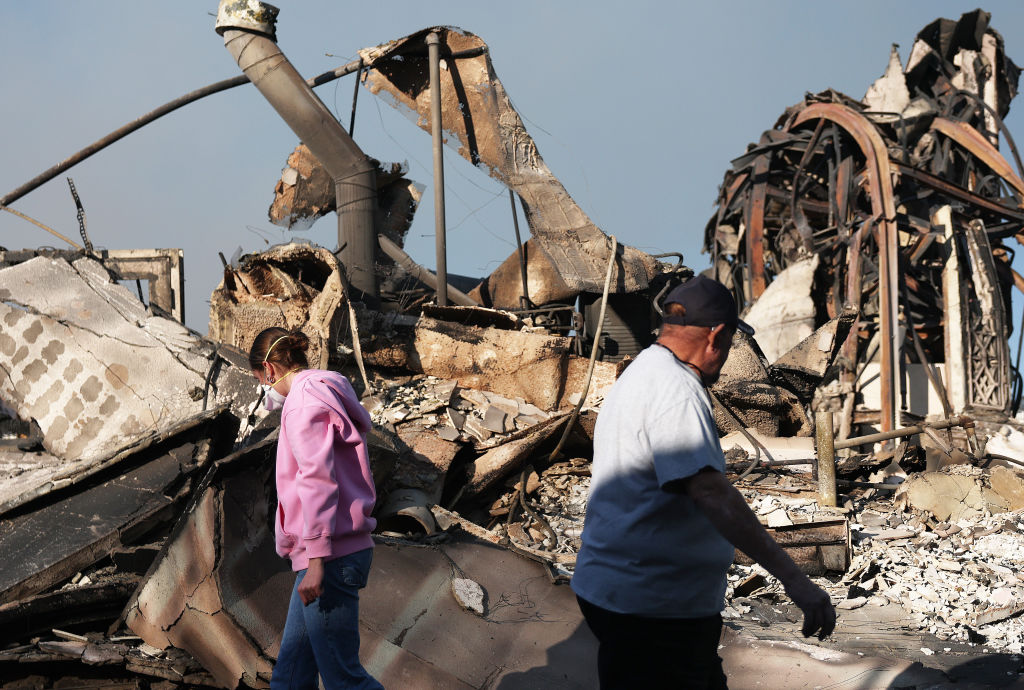"It's a war": California turns to new, high-tech helicopters to battle wildfires
California is burning — on track for the most savage fire year in its history. Drought and scorching temperatures have turbocharged fires that are more extreme than ever. Two of the biggest fires in state history have laid siege to more than a million acres in Northern California, burning dangerously close to Lake Tahoe. Firefighters haven't had a day off in months. Fire chiefs warn there aren't enough aircraft to go around. "It's a war," one told us. Now, fire chiefs from Southern California have stolen a page from the military: take the fight to the night. A new fleet of hi-tech helicopters will fight wildfires 24/7. And for the first time, the giant Chinook — you've seen them in other war zones — will lead the night assault. It's an $18 million pilot program the fire chiefs hope will be a game changer.
The U.S. Forest Service was already short-staffed when the Caldor Fire exploded last month, churning toward South Lake Tahoe. Thousands of residents were forced to flee. To the north, the Dixie Fire has been rampaging for months, demolishing historic gold rush towns. The drought-parched forests burn so hot they generate their own fire tornados. Between the two infernos, more than 8,000 bone-weary firefighters have been waging a relentless battle. Orange County Fire Chief Brian Fennessy — a former Hotshot who's been fighting fires in Southern California for 44 years — told us there is no more give in the system.
Brian Fennessy: These fires get so large that there aren't enough firefighters, aren't enough airplanes, helicopters, bulldozers.
Bill Whitaker: I would think that would be worrisome .
Brian Fennessy: You know, we're to the point where if we were to send much more, we're going to have firehouses that are empty. And for the people that we've sworn to serve, you know, our taxpayers, it's not acceptable to have firehouses empty for any length of time.
Bill Whitaker: Everything is stretched to the limit.
Brian Fennessy: Everything is stretched.
We met Brian Fennessy at the Truckee Airfield, about 45 miles from the fires. After Caldor destroyed the town of Grizzly Flats, Fennessy volunteered to send his new firefighting choppers north. More like flying computers with rotors on top, they're called the Quick Reaction Force. Fennessy calls the fleet, "The Hammer."
Brian Fennessy: This is The Hammer!
Bill Whitaker: So if someone calls 911
Brian Fennessy: If something breaks out
Bill Whitaker: You hit it with everything you've got, these big guys and knock it out.
Brian Fennessy: In case of fire, break glass.
The star of the show is the massive Chinook – this one used to fly in Afghanistan for the U.S. Army. It's been retrofitted to fight a different war, dropping water or retardant. Now, Fennessy told us they have this powerful new tool to take that fight to the night.
Brian Fennessy: The ability to lay retardant line, to continue to drop fire retardant after sundown, that's a first.
Bill Whitaker: That's gonna change the way you fight fires?
Brian Fennessy: We hope so.
The Chinook can drop 3,000 gallons. That's about 10 times what most firefighting choppers drop. No bigger helicopter has ever fought fires at night.
Wayne Coulson, the CEO of Coulson Aviation — which built the fleet — is a pioneer in night firefighting. He showed us the specially-designed tank. Computers control the tank's doors, opening at precise GPS points.
Bill Whitaker: You can zero in exactly on the spot you want to drop?
Wayne Coulson: We can fly the aircraft to those GPS points and the doors will automatically open and close between those two points.
Coulson told us it's a more surgical strike. Flame retardant can be dropped in almost straight lines. At night, there's an added advantage: the fire usually dies down.
Bill Whitaker: Is that a better time to hit the fire?
Wayne Coulson: It absolutely is. That's when it's its weakest.
Bill Whitaker: Usually its weakest?
Wayne Coulson: That's the time to attack an enemy, at its weakest point in time.
The Quick Reaction Force works in pairs. The Chinook gets its orders from this aircraft. Think of it as a traffic control tower — but in the air. Wearing night vision goggles, Orange County Air Attack officer Joel Lane uses infrared cameras to see through the smoke to map the best targets for the Chinook.
Lane has spent the last 23 years in the air. Improved night vision technology has revived night firefighting — most agencies halted night flying after a mid-air collision in the 1970s. Lane told us the technology means they can attack fires at any hour.
Joel Lane: If you time a fire let's say for one minute, and its 2 acres, in two minutes, it's not gonna be 4, it's gonna be 9. And in three minutes, it's gonna be 27.
Bill Whitaker: And the fire's going faster.
Joel Lane: And the only thing that stops that is speed and force.
Bill Whitaker: And that's what you get with the aircraft?
Joel Lane: That is exactly what you get with the aircraft.
In early September we flew with Britt Coulson, Wayne's son and tech wizard at Coulson Aviation. He turned on the powerful thermal imaging camera and the Caldor Fire burst into view.
Britt Coulson: Those flames are higher than the trees.
As we flew closer, we watched a fountain of flames exploding over the treetops. There was fire everywhere, every point of light a potentially hellish new blaze.
Britt Coulson: The embers that come up when it's really intense, they're gonna spot out far ahead.
Zooming in, Britt Coulson showed us a spot fire that had leapt over a containment line dug by firefighters.
Wayne Coulson: So let's say if they were trying to catch it along that ridgeline there.
Bill Whitaker: This has already jumped over?
Wayne Coulson: It's jumped over. Without this type of technology, they're never gonna see that.
We circled the fires at 13,000 feet. Below us, we spotted the command helicopter with Joel Lane. A thousand feet below that is where the Chinook flies. Lane directs the big chopper to the drop zone. From our perch, we could almost count the trees as we flew over a blackened landscape. Then we saw boats, docks and houses: South Lake Tahoe.
Wayne Coulson: That's South Lake Tahoe airport right there. And then you got the fire right there.
Bill Whitaker: Right behind it.
Wayne Coulson: So there, you've got all the individual embers coming up.
Bill Whitaker: That's burning heavily.
Wayne Coulson: Yeah.
The Chinook sweeps across the flames, drops its water, then heads to the nearest lake to refill. Unlike fixed-wing craft that have to return to base, the Chinook can refill anywhere. Hovering like some prehistoric bird, it sucks up 3,000 gallons in 90 seconds.
This doesn't come cheap. A helitanker can cost up to $15 million, and $8,000 an hour to operate. But Joel Lane told us it's money well spent.
He told us about the Tuna Fire, which ignited in dry brush near Malibu in July. It was promptly doused by a Quick Reaction Chinook at a cost of several hundred thousand dollars, a fraction of what it would have cost if the fire had gotten out of control. If you never heard of the Tuna Fire, says Lane, that's a win.
Joel Lane: So the 10-acre fire that you—that we catch 98% of the time, it's never gonna make the paper, you're never gonna hear about it. Public wakes up the next day and unless they drive by it, they never know it happened. And we do that very successfully, especially in Southern California.
Bill Whitaker: The finances that you're laying out, that, yes, it's expensive to have these aircraft but it's more expensive if you don't catch the fire.
Joel Lane: Exponentially.
Bill Whitaker: Exponentially more expensive?
Joel Lane: Correct.
In Northern California, the Dixie Fire is now the largest single fire in state history. Exhausted firefighters are still fighting the Caldor Fire. The cost? More than a half-billion dollars and climbing. Yet during our trip, the helitankers flew only one out of four nights. We wondered why? So did Orange County fire chief Brian Fennessy, who had sent his best equipment to fight the state's worst fires.
Bill Whitaker: Did they not put it to work as soon as you brought it up here?
Brian Fennessy: Not not initially, no.
Bill Whitaker: Why not?
Brian Fennessy: It took a lot of— they didn't have any familiarization with you know flying at night. And so we had to slow down.
Bill Whitaker: But it's proven.
Brian Fennessy: And we're in the middle of chaos and uncertainty and homes are burning, that doesn't work.
In the week we were there, the Caldor Fire grew by 40,000 acres. Perhaps as alarming: we discovered the slow down was fueled, in part, by infighting between the U.S. Forest Service, which oversees federal lands, and Cal Fire, responsible for state forests. Chief Fennessy told us he twice offered up his new fleet, and twice met with discord and confusion.
We saw the forest service sign off on decisions, only to have them changed by Cal Fire. Firefighters told us the agencies disagreed about night missions, radio frequencies, how to feed firefighters. They both challenged the credentials of the Orange County flight crews.
Bill Whitaker: That doesn't seem like the most efficient way to handle the resources, especially in the face of a huge fire?
Brian Fennessy: Extremely frustrating. We have a system, the Fire Service, where we honor each other's qualifications. Yeah, it is frustrating because you know when there's a delay in accepting these qualifications to the detriment of the public, yeah, that's a concern.
When Chief Fennessy first sent his choppers, two crews sat on the tarmac for 48 hours. Fed up, he protested in an email, which we obtained through a Freedom of Information request.
"I don't think the public will understand this nonsense," he wrote. "Especially if our crews are grounded and there are no aviation safety issues to address."
Cal Fire told us the crew check was a standard safety procedure and that smoke and wind prevented flying some nights. Chief Fennessy told us only when he threatened to take his choppers back south, did the agencies give the green light to fly.
Still, Brian Fennessy and two other Southern California fire chiefs were so dismayed the fleet was being used so little, they complained in an email to the Forest Service: "there was ample opportunity for the safe consistent operation of the [Quick Reaction Force] both during the day and at night, but this did not occur."
Brian Fennessy: Well I have an expectation that if I'm going to loan you, you know, my stuff 'cause you're having an emergency, you're going to put it to work. If you're not going to put it to work, send it home 'cause I've got work and I've got citizens here to protect. We're going to go to work.
Fennessy told us the intensity of these fires demands a new approach to fighting them.
Brian Fennessy: I'd heard from agencies at the highest level, that there was not a concern for aviation safety. It was more of a concern for--
Bill Whitaker: Bureaucracy....?
Brian Fennessy: You said it.
Bill Whitaker: The fires are changing ...
Brian Fennessy: The fires are changing. We've got to be more—
Bill Whitaker: The climate is changing
Brian Fennessy: Oh— we— we've got to be more nimble. We've got to be able to pivot very quickly —
Bill Whitaker: Fires aren't going to wait for you to get your act together.
Brian Fennessy: No, they're not.
We repeatedly asked Cal Fire and the Forest Service why the night-flying choppers weren't used more. Weeks later, they did get together to issue a joint statement about their "shared mission."
They wrote: "Each fire presents its own unique challenges and fire managers stand shoulder-to-shoulder every day to overcome these hurdles..."
The day after we left, Chief Fennessy took his Quick Reaction Force back south where the Santa Ana winds and the number of fires are picking up. Fennessy told us, with fires getting more extreme, Cal Fire and the Forest Service can't afford to sideline the Big Hammer.
Brian Fennessy: These aircraft are being credited with saving countless property because they were available at night to do that.
Bill Whitaker: And you've proven it.
Brian Fennessy: We've proven it. It's a program that I believe needs to expand not just to Northern California, but throughout the West.
Bill Whitaker: What's the resistance? Why the resistance?
Brian Fennessy: You know, my gut tells me based on decades of experience in the Fire Service that there's just an inherent resistance to change. But we've got to evolve. We've got to pivot. We are standing, you know, in a new world. It's not a new norm. It's the norm.
Produced by Heather Abbott. Associate producer: LaCrai Mitchell. Broadcast associate: Emilio Almonte. Edited by Warren Lustig.

